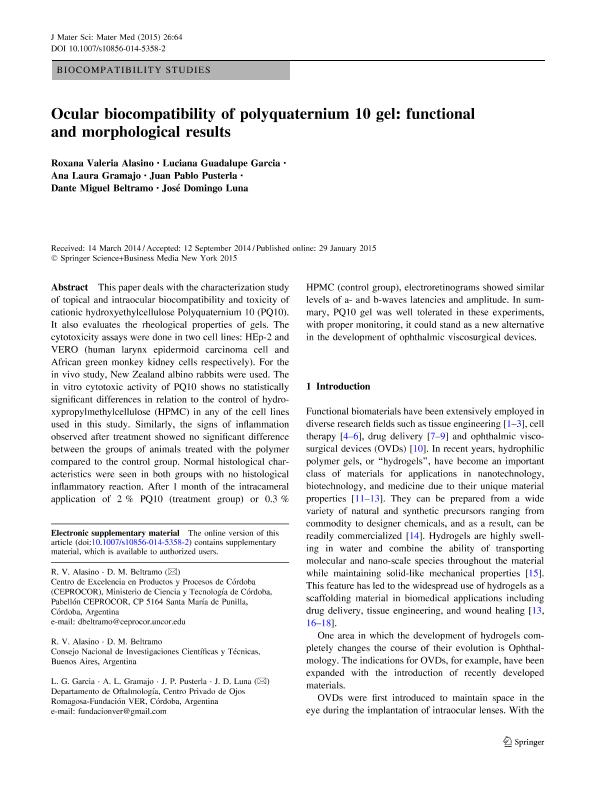Mostrar el registro sencillo del ítem
dc.contributor.author
Alasino, Roxana Valeria

dc.contributor.author
Garcia, Luciana Guadalupe
dc.contributor.author
Gramajo, Ana Laura

dc.contributor.author
Pusterla, Juan Pablo
dc.contributor.author
Beltramo, Dante Miguel

dc.contributor.author
Luna, José Domingo

dc.date.available
2022-12-05T11:52:00Z
dc.date.issued
2015-02
dc.identifier.citation
Alasino, Roxana Valeria; Garcia, Luciana Guadalupe; Gramajo, Ana Laura; Pusterla, Juan Pablo; Beltramo, Dante Miguel; et al.; Ocular biocompatibility of polyquaternium 10 gel: functional and morphological results; Springer; Journal of Materials Science: Materials In Medicine; 26; 2; 2-2015; 1-10
dc.identifier.issn
0957-4530
dc.identifier.uri
http://hdl.handle.net/11336/180108
dc.description.abstract
This paper deals with the characterization study of topical and intraocular biocompatibility and toxicity of cationic hydroxyethylcellulose Polyquaternium 10 (PQ10). It also evaluates the rheological properties of gels. The cytotoxicity assays were done in two cell lines: HEp-2 and VERO (human larynx epidermoid carcinoma cell and African green monkey kidney cells respectively). For the in vivo study, New Zealand albino rabbits were used. The in vitro cytotoxic activity of PQ10 shows no statistically significant differences in relation to the control of hydroxypropylmethylcellulose (HPMC) in any of the cell lines used in this study. Similarly, the signs of inflammation observed after treatment showed no significant difference between the groups of animals treated with the polymer compared to the control group. Normal histological characteristics were seen in both groups with no histological inflammatory reaction. After 1 month of the intracameral application of 2 % PQ10 (treatment group) or 0.3 % HPMC (control group), electroretinograms showed similar levels of a- and b-waves latencies and amplitude. In summary, PQ10 gel was well tolerated in these experiments, with proper monitoring, it could stand as a new alternative in the development of ophthalmic viscosurgical devices.
dc.format
application/pdf
dc.language.iso
eng
dc.publisher
Springer

dc.rights
info:eu-repo/semantics/openAccess
dc.rights.uri
https://creativecommons.org/licenses/by-nc-sa/2.5/ar/
dc.subject
CATIONIC CELLULOSE
dc.subject
OPHTALMIC VISCOSURGICAL DEVICES
dc.subject
OPTHALMIC HYDROGELS
dc.subject
RETINAL DAMAGE
dc.subject.classification
Biomateriales

dc.subject.classification
Biotecnología de la Salud

dc.subject.classification
CIENCIAS MÉDICAS Y DE LA SALUD

dc.title
Ocular biocompatibility of polyquaternium 10 gel: functional and morphological results
dc.type
info:eu-repo/semantics/article
dc.type
info:ar-repo/semantics/artículo
dc.type
info:eu-repo/semantics/publishedVersion
dc.date.updated
2022-12-05T10:47:05Z
dc.journal.volume
26
dc.journal.number
2
dc.journal.pagination
1-10
dc.journal.pais
Alemania

dc.description.fil
Fil: Alasino, Roxana Valeria. Provincia de Córdoba. Ministerio de Ciencia y Técnica. Centro de Excelencia en Productos y Procesos de Córdoba; Argentina. Consejo Nacional de Investigaciones Científicas y Técnicas. Centro Científico Tecnológico Conicet - Córdoba; Argentina
dc.description.fil
Fil: Garcia, Luciana Guadalupe. Fundación Ver; Argentina
dc.description.fil
Fil: Gramajo, Ana Laura. Fundación Ver; Argentina. Consejo Nacional de Investigaciones Científicas y Técnicas; Argentina
dc.description.fil
Fil: Pusterla, Juan Pablo. Fundación Ver; Argentina
dc.description.fil
Fil: Beltramo, Dante Miguel. Provincia de Córdoba. Ministerio de Ciencia y Técnica. Centro de Excelencia en Productos y Procesos de Córdoba; Argentina. Consejo Nacional de Investigaciones Científicas y Técnicas. Centro Científico Tecnológico Conicet - Córdoba; Argentina
dc.description.fil
Fil: Luna, José Domingo. Fundación Ver; Argentina
dc.journal.title
Journal of Materials Science: Materials In Medicine

dc.relation.alternativeid
info:eu-repo/semantics/altIdentifier/doi/http://dx.doi.org/10.1007/s10856-014-5358-2
Archivos asociados
